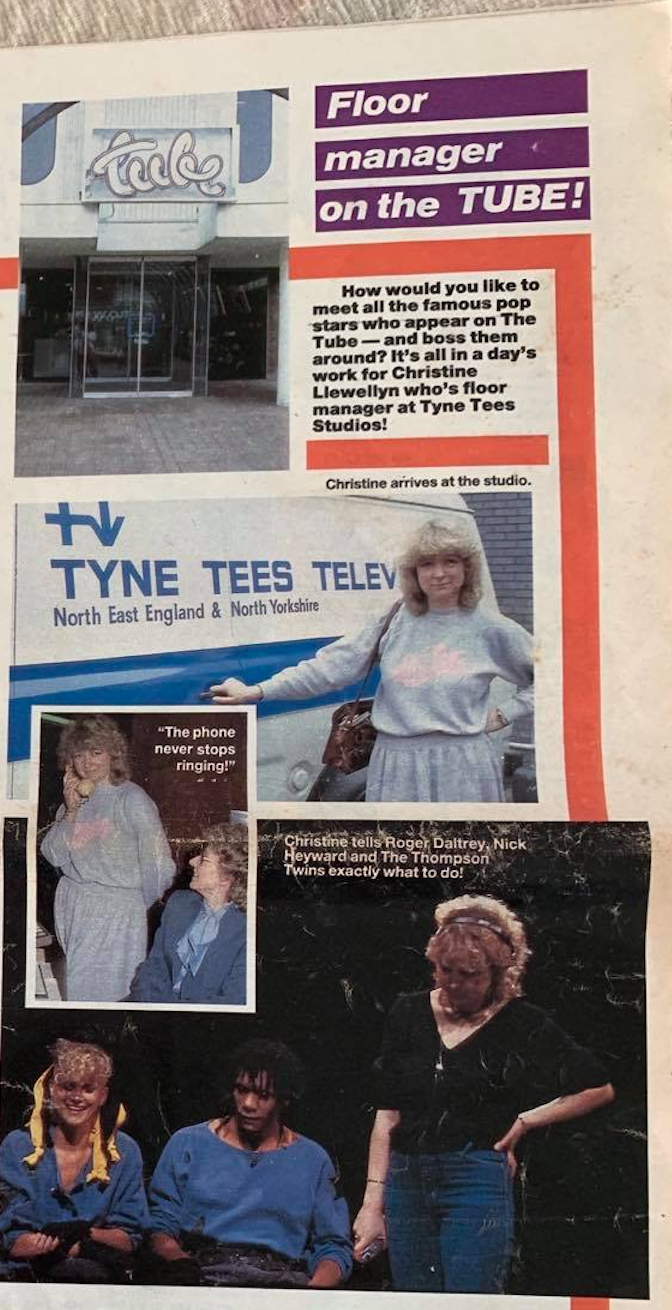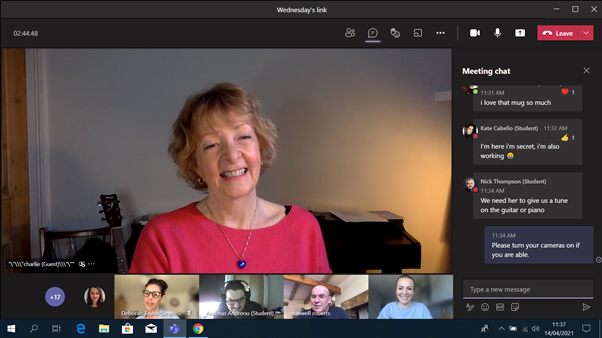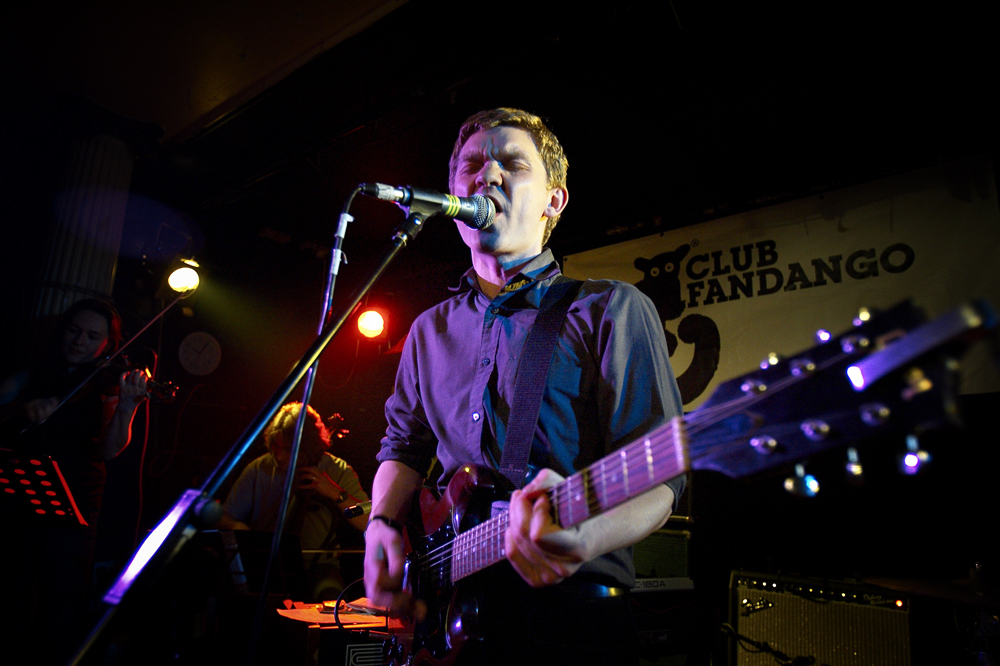STANDBY and get ready as we transmit you through a whole time “tube” of Tyne Tees Television nostalgia plus an exclusive interview with Christine Llewellyn-reeve, a former floor manager on Channel 4’s The Tube.
EXCLUSIVE: An interview with the former Tube floor manager, Christine Llewellyn-reeve

Photo courtesy of Ms Christine Llewellyn-reeve – Facebook Christine Llewellyn-reeve
ON Thursday March 11, 2021, I sat down with the former Tube floor, then promoted Senior floor manager Ms Christine Llewellyn-reeve who was there for the whole of its five year run and reminisced about the legendary 80’s music television show The Tube, produced by Tyne Tees Television for Channel 4.
Ms Llewellyn-reeve, who had a theatrical background of eight years as an actress, began her career at Tyne Tees Television in promotions. 18 months later, opportunities popped up to become a studio floor manager and Ms Llewellyn-reeve applied for the position.
After waiting to hear if she was successful, the role was hers. The significance of Ms Llewellyn-reeve landing the role as a studio floor manager was that she officially became the first female floor manager in the whole of ITV in 1981.
Soon after, talks about a brand-new live music television show were discussed with Andrea Wonfor, the inventor of The Tube and Malcolm Gerrie, who would go onto become the show’s producer. Ms Llewellyn-reeve told me: “I remember sitting round our canteen at Tyne Tees and Andrea Wonfor and Malcolm Gerrie saying to me ‘Oh we are going to do a new show and it’s going to be an hour and a half of live telly on a Friday night.
“’We’re gonna have bands from all over the country.’”
Inspiration for The Tube came from ITV’s Ready, Steady, Go which was a 60’s live music television show with live bands and completely hip presenters. The Tube followed the same format in being live which created this fantastic atmosphere of never knowing what was going to happen.
Studio 5 which was built primarily for The Tube had a big Perspex canopy which lead to the studio from City Road, and this is where the show “The Tube” got its name.
Talking about her role as a studio floor manager, Ms Llewellyn-reeve said: “There were always two floor managers allocated to The Tube and as we were the head of a team of 40 people, we had to make sure that everyone, the bands, presenters, props, effects everything were all responsible and utterly professional in their own right.
“My second function was to communicate and place floor markings on the studio floor for the presenters, Jools Holland, ex-keyboardist for Squeeze and Paula Yates, the crew, the bands if necessary and getting people to the right place at the right time.”
Asking Ms Llewellyn-reeve about the differences between the BBC’s music show Top Of The Pops and Channel 4’s The Tube, she said: “The producers wanted it to feel like a live gig for the bands.
“The whole way it was done was as if they’d come to the City Hall or another one of the big venues. We also used the Egypt Cottage pub next door for the setting of the interviews with the big names because they wanted to be innovative.
“They deliberately did links from unusual places which made the show even more unique.”
Further to the show being unique, the team were cutting and shooting the show live. They relied on the cameramen to offer the shots. “Normally the production assistant and director would work out every-single camera shot in advance and would be pre-planned. The Tube didn’t do this.
“The producers were innovative, and they allowed each camera to cover certain actions or people. During rehearsal and transmission, they had a visual mixer who was musically trained which was unusual and she would count the bars. This hadn’t been done before.”
The BBC were very much interested in The Tube’s approach to being different and sent out a BBC delegation to the show because they wanted to see how it was done so that they could take these methods for their show Top Of The Pops.
After an incredible five years of the Friday night gig live in people’s living rooms up and down the UK, on April 24, 1987, Yates signed off by closing the Studio 5 door for the very last time.
Ms Llewellyn-reeve stated that: “We were very sad that it finished. It put the North-East on the map for five years, especially the first two or three years.”
According to Ms Llewellyn-reeve, the presenters for half of the year would come up to Newcastle on a Wednesday and go back to wherever it was they’d come from on a Saturday morning. Ms Llewellyn-reeve believes that some of the reasons for The Tube’s cancellation was to do with that.
To wrap up our conversation, I asked Ms Llewellyn-reeve about her best memories that she has cherished from her five-year run working on The Tube. She said: “Tina Turner did her comeback performance in the UK.
“She’d hadn’t been anywhere else. She did it on The Tube. I was in the audience and I was completely gobsmacked. She stayed on and did another two or three numbers which we recorded after we’d gone off air.”
“Another one of my standout memories was on one of the shows, the crew decided to dress up in fancy dress and by the time I got to wardrobe, they only had one outfit left which was Little Miss Muffet.
“It also happened to be the day that we had a celebration of heavy metal. I was moving Motorhead around the studio and onto the stage and counting them down and also Twisted Sister were there too, who I adored.
“They looked terrifying in their gear and gothic makeup and I remember the lead singer of Twisted Sister coming out of his dressing room with about five minutes before transmission and the six- or seven-foot terrifying looking man saying to me: ‘Chris, I’m lost, can you get me to the studio’.
“He took my hand and I let him by the hand dressed as Little Miss Muffet all through the corridors to get him on stage. He was the complete opposite from his image.
“They were so professional because they were taking us off air and he said: ‘I want you to count me down’ and he went through all of the signs and said: ‘I will take the count and I will get you off air and will go out to the second’.
“I counted him out to the 16th of a second.”
Ms Llewellyn-reeve wanted to also say that: “It was so wonderful working on The Tube and that I was just delighted. They were all like an extended family at Tyne Tees Television.”



